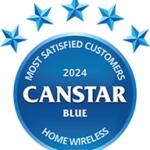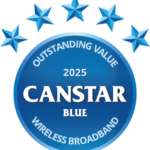Compare the best home wireless broadband plans
Looking for a better home wireless broadband plan? Compare some of the best home wireless plans from the online partners on Canstar Blue’s database so you can find the network, speed and price combination that will best suit your needs.

-
Modem Included, no setup fees
-
Modem Included, no setup fees
-
Modem Included, no setup fees
-
Modem Included, no setup fees
-
Modem Included, no setup fees
-
Modem Included, no setup fees
Showing 6 of 25 results
To see more results adjust the filters above
Unsure of a term in the above table? View glossary
The initial results in the table above are sorted by Cost per month (Low-High) , then Value Rank out of 10 (High-Low) , then Provider Name (Alphabetical) . Additional filters may have been applied, which impact the results displayed in the table - filters can be applied or removed at any time.
SPONSORED
NBN Fixed Line | no lock-in contract
-
The speed you need, the price you want.
-
Save $20/mth off Dodo’s NBN500 plan for 12 months.
-
Offer ends 24 February 2026. New and returning nbn customers only.
What is home wireless broadband?
Home wireless broadband is technology that allows a modem to access the internet remotely, generally by using the same 4G or 5G mobile networks that connect your phone. Unlike NBN, home wireless doesn’t need to connect to a fixed line in your wall; instead, you can plug in a home wireless modem into any power outlet. While home wireless broadband and mobile broadband use the same technology, home wireless plans come packaged with a modem/router, and are designed to be used as a replacement for a fixed line internet connection.
Home wireless broadband is also known as wireless internet, wireless broadband, and — depending on the mobile technology used — 4G home internet or 5G home internet. All home wireless plans will offer coverage on either Telstra, Optus or Vodafone’s networks, even if you buy from a smaller telco.
A home wireless plan can be a good alternative to NBN or fibre internet, but can sometimes be inconsistent or slow compared to fixed line broadband, especially on 4G-only plans.
Best home wireless internet plans
Choosing the best home wireless broadband plan will ultimately depend on what you need from an internet plan — what your internet needs are, what plans are available to you and what your budget is.
5G home internet plans are going to offer the fastest speeds compared to 4G home internet plans. However, 5G home internet is still not as widely available as 4G home internet, so you might find that you don’t have network coverage at your address.
Another thing to watch out for is whether the home wireless plan has a speed cap. Some providers might offer multiple home wireless plans with different speed caps in place, which aligns plans more with the speeds available on the NBN. This means that some plans from some providers will be cheaper because of the speed cap, while other plans may be more expensive if it offers uncapped speeds.
If you’re looking for a 5G home internet plan and want to take advantage of the fast speeds available with 5G, you might prefer to compare uncapped plans. However, if price is more important to you, a capped-speed plan, or 4G home internet plan, might better suit your budget.
Telstra 5G home internet
The only Telstra home wireless broadband plan is a 5G home internet plan. If you don’t have access to Telstra’s 5G network, this plan might not be available to you at your address — you’ll need to use the address checker on the Telstra website before signing up.
The Telstra 5G home internet plan is only available bundled with a Telstra modem and you’ll get 1TB of data with your plan. Telstra lists its range of expected download speeds to be between 30Mbps and 570Mbps, while its upload speed range is between 5Mbps and 70Mbps.
Optus 5G home internet
Optus offers several home wireless broadband plans, including a simple 4G home internet plan and three 5G home internet plans. The cheapest plan has speeds capped at 50Mbps, the middle plan has 100Mbps capped speeds, while the most expensive plan includes unlimited speeds and a free Netflix subscription. You will also need the supplied Optus 5G modem, which is free if you stay connected for 36 months.
TPG 5G home internet
TPG offers several different home wireless broadband plans, including a 4G home internet and two 5G home internet plans. While the TPG 5G home internet plans are cheaper than the Telstra and Optus 5G home internet plans, TPG doesn’t offer an uncapped speed plan. You’ll only have the choice between a plan with 50Mbps and 100Mbps.
Other home wireless broadband providers
Telstra, Optus and TPG are three of the biggest internet providers in Australia, however if you’re looking for a home wireless plan, these aren’t your only options. Both iiNet and Vodafone — which are part of the TPG Telecom group alongside TPG — also offer a range of home wireless plans, as do Kogan, SpinTel, Southern Phone and Yomojo.
Why compare home wireless broadband plans with Canstar Blue?
Easy to compare
Compare a range of wireless broadband plans and providers by speed, price, modem inclusions and more.
100% free to use
Our internet comparison tool is free to use, so you can find the best home wireless broadband plan for you.
Switch with confidence
Compare wireless broadband plans from a range of providers to find the best plan for your household.
How to compare home wireless broadband plans
- Compare using Canstar Blue to find the right home wireless broadband plan for you. You’ll want to look at your budget, the speed you’ll need for your household size and usage, the required data amount (if applicable), and if you want any extras.
- Sign up with your new provider. If you’ve found a great plan with Canstar Blue’s comparison tool, you can click through in your search results to be taken straight to the provider’s website. You can order a new plan easily online.
- Contact your current provider to cancel your old internet plan and settle any remaining bills and charges. Once you’ve received your home wireless broadband modem and SIM card, simply plug it in and you’ll be connected in minutes.
How to choose the best home wireless broadband plan
Choosing the best home wireless broadband plan for your needs can be daunting, but ideally you’ll want to look for a combination of three factors: internet speed and network type, monthly price, and data allowance.
If you’re still unsure about which home wireless broadband plan and provider is best for you, each year, Canstar Blue surveys Aussies to determine which internet provider offers the best customer satisfaction for home wireless plans.
Home Wireless Broadband Providers: Most Satisfied Customers award winner
iiNet was our 2024 Most Satisfied Customers award winner for home wireless broadband providers, scoring five stars across all categories, including overall satisfaction, speed and coverage, and value for money.
Best-Rated Home Wireless Providers
Home Wireless Broadband Providers: Outstanding Value award winner
Our joint winners for the 2025 Outstanding Value award for wireless broadband plans were iiNet and TPG. Both brands offered a good balance between price and included features, especially for the higher-speed 5G plans.
Outstanding Value AwardsCompare home wireless broadband speeds
With 5G technology rolling out across Australia, wireless internet customers may have the choice between 4G or 5G speeds in eligible areas. 4G is more widely available, and tends to be slightly cheaper, with speeds generally reaching around 25 megabits per second (Mbps) in busy periods. This is similar to what you’ll experience on an NBN 25 plan. Some 4G plans may also reach faster speeds in off-peak hours.
5G is much faster than 4G, and is ideal for bigger families or homes that have more intensive usage needs, such as multiple video streams or online gaming. Most providers that offer 5G home wireless now give customers a choice of speed caps, and usually sell 50Mbps and 100Mbps plans. However, Telstra and Optus do offer uncapped 5G speeds on selected plans, with typical busy hour download speeds usually anywhere between 200-400Mbps.
Do you know how fast your internet speed is?
Compare home wireless broadband prices
Home wireless broadband plans tend to start at around $55 per month, with maximum prices at around the $99 monthly mark for superfast 5G. Pricing is determined by your plan’s network technology and speed (e.g 4G or 5G, and if speeds are capped), as well as the plan’s data inclusions.
If you’ve got a budget in mind, this can help narrow down your options, although you’ll want to make sure your plan has enough speed and data for your home. You may also want to consider extras, such as included modems, antivirus protection, or entertainment (for example, Optus includes a Netflix subscription in its most expensive home wireless plan). All of these may drive up the price of your monthly bill.
If you are a new customer, you may be eligible for an introductory discount for your first six or 12 months — these offers will be highlighted in our comparison tool. Generally, home wireless broadband plans can be cheaper or on par with NBN plans at a similar speed, so can be a great-value option for homes without reliable NBN access.
Compare home wireless broadband data
Most wireless internet providers now offer unlimited data across most plans, which means you won’t need to worry about excess data charges. If you’re shopping for a 4G home wireless broadband plan, data-capped options are still available from some telcos, which may be worth considering if you’re not a heavy user — just be careful not to exceed your monthly limit.
Almost all 5G home wireless broadband plans include unlimited data, with the exception of Telstra’s plan. Telstra offers customers a data allowance of one terabyte each month, or 1,000GB. This should be more than enough for the vast majority of homes, but if you do go over, you won’t be charged for excess data usage. Instead, your speeds will be slowed to 25Mbps for the rest of your billing cycle.
What are the pros and cons of home wireless broadband?
Pros:
- Home wireless broadband is easy to set up, and can be taken with you if you move house
- It’s a fast alternative for customers who can’t access NBN, or are unhappy with their NBN performance
- 4G is available to most of the population, with 5G coverage continuing to roll out nationwide
- Home wireless plans can be cheaper than equivalent speeds on NBN
- Most plans now include unlimited data
Cons:
- Home wireless broadband relies on mobile network coverage, so will struggle in areas with poor reception
- Much smaller range of plans and providers to choose from when compared to NBN
- Fast 5G speeds are not available everywhere, and 4G speeds may be too slow for big households or heavy users
- It’s not always as reliable as fixed-line internet, and speeds can be affected by heavy network traffic
About our internet experts
Tara Donnelly, Utilities Editor
Tara Donnelly is Canstar Blue’s Utilities Editor, leading the team that focuses on energy, telecommunications and consumer technology, across news, reviews and how-tos. Tara has spent more than a decade covering these topics in Australia, the US and Canada, which means she’s written about countless product launches and industry changes, including the rise of 5G, Australia’s ongoing NBN rollout, the recent years of energy price volatility and the rise of renewable energy sources.
Tara also has long experience in writing within the comparison industry, giving her great insights into the information consumers want when determining which plan or device will best meet their needs, while time spent in the financial sector before turning her talent to content lets her crunch the numbers on price with ease. Tara leads the coverage of Canstar Blue’s ratings and awards for the internet and phone sectors and is an expert at advising consumers on how to use comparison tools to find the best power, internet or phone deal.
Her expertise has seen her appear in national media including 9 News, 7 News, Sunrise, the ABC , The Australian Financial Review, 4BC Radio and The Sydney Morning Herald.
Meet the Editorial Team
Josh Filosi, Data Insights Analyst
Josh Filosi is a Data Insights Analyst at Canstar, where he uses his expertise in data analysis and interpretation to develop and deliver the methodology for Canstar Blue’s Value Rankings and Outstanding Value awards in the telecommunications sectors.
His double-major in Economics and Behavioral Science from Griffith University provides him with the analytical skills and understanding of consumer markets to uncover insights in complex data, as well as passion for helping consumers find genuinely good deals when faced with countless competing options for their hard-earned cash in the Internet and Phone sectors.
Josh’s real love for all things tech gives him a unique perspective, too, on the telecommunications industry and the needs of its customers – staying up-to-date with the latest developments in the field is no onerous task, and it means Josh spots small details that can add up to a big difference to customers. He recently worked on the development of a Value Ranking methodology for the growing wireless broadband sector.
Josh relishes the opportunity to dedicate his professional effort to the cause of tech and telco users and is keen to continue building his understanding of this fascinating, ever-changing industry. When Josh isn’t poring over telco data, he likes to tinker with gadgets and electronics.
Meet the Research Team
FAQs about home wireless broadband plans
Important information
For those that love the detail
This advice is general and has not taken into account your objectives, financial situation or needs. Consider whether this advice is right for you.









